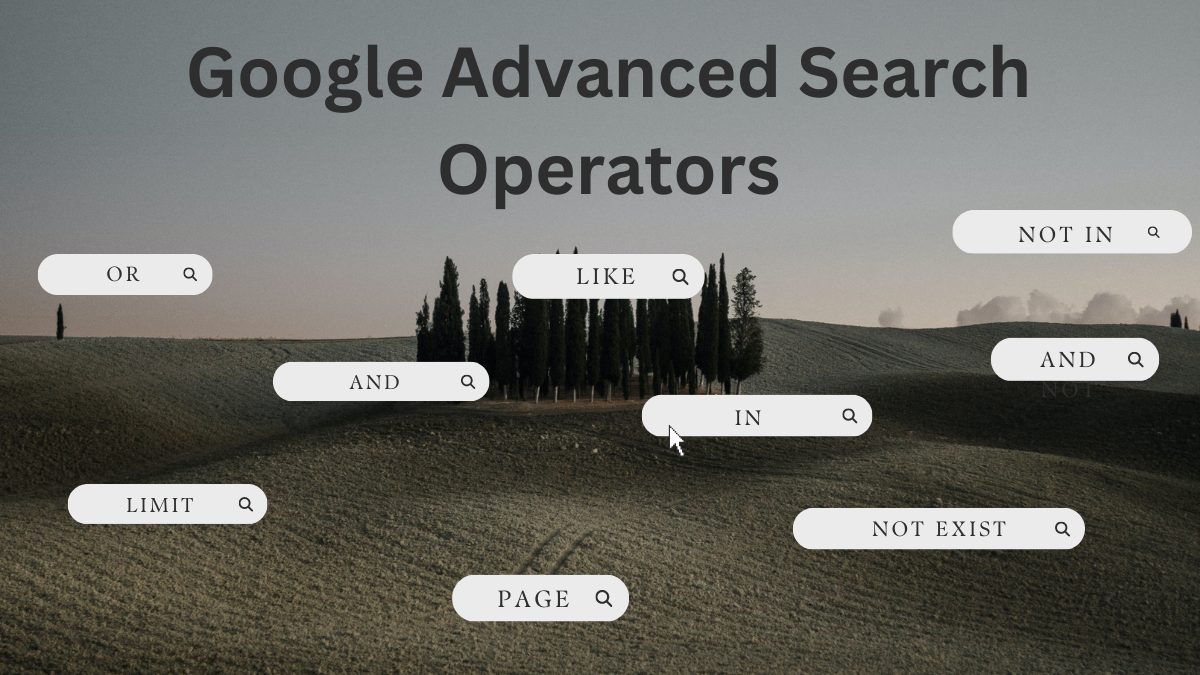Google Advanced Search Operators
Are you tired of sifting through endless search results on Google, hoping to find that one elusive piece of information? Well, fret no more! In this blog post, we are going to unlock the secret power of Google Advanced Search Operators – a set of commands that will take your search skills to the next level.
Whether you’re a student looking for credible sources or a professional hunting down specific data, these operators will be your trusty sidekick in navigating the vast realm of online information. So buckle up and get ready to become a master searcher with our ultimate guide to Google Advanced Search Operators!
Table of Contents

What are Google Advanced Search Operators?
Advanced search operators are a powerful tool that you can use to refine your search results. They allow you to narrow down your results by specifying specific criteria, such as location, time, or content type. Here are some of the most commonly used advanced search operators:
- AND: This operator allows you to combine multiple search terms. For example, if you want to find all recipes that include both chicken and beef, you would use the AND operator (chicken AND beef).
- OR: This operator allows you to choose between two sets of search terms. For example, if you wanted to find all recipes that include either chicken or beef, you would use the OR operator (chicken OR beef).
- NOT: The NOT operator is used to exclude certain values from a search term. For example, if you wanted to find all recipes that don’t include beef, you would use the NOT operator (beef NOT).
- IN: The IN operator allows you to search for specific values within a set of words. For example, if you wanted to find all recipes that include eggs, you would use the IN operator (eggs).
- NOT IN: The NOT IN operator is used to search for specific values that are not within a set of words. For example, if you wanted to find all recipes that don’t include eggs, you would use the NOT IN operator (eggs NOT).
- AND NOT: The AND NOT operator is used to exclude a search term if the search term is not found. For example, if you wanted to find all recipes that include both chicken and beef, but exclude beef recipes that include mushrooms, you would use the AND NOT operator (chicken AND ( Beef OR mushrooms)).
How do they work?
- Google’s advanced search operators can be a little confusing at first, but they are quite simple. They allow you to do things like search for specific terms, including a range of dates or times, and find documents that have specific keywords in them.
- To use the advanced search operators, first, click on the “advanced search” link on the main Google page. This will take you to the main advanced search page. To add an operator, click on the “add operator” button near the top of the page. Then type in your desired term and hit enter. Google will then show you all the results that have that term in them.
- To include a range of dates or times, just put “/between/” followed by two dates or times (or date and time). For example, if you wanted to look for results between January 1st and January 31st, you would type “/between/1/1/2015/-1/31/2015”.
- To find documents that have specific keywords in them, just put “/contains/” followed by one or more keywords. For example, if you wanted to find all the documents that had the word “travel” in them, you would type “/contains/travel”.
Google also has an “advanced search” button on the main search page that allows you to do things like restrict your search to a specific country or continent, specify a language, or limit your results to websites only.
Remember, Google’s advanced search operators are just that- advanced. If you’re not sure how to use them, just give us a call and one of our experts will be happy to help you out!

What can you use them for?
Advanced search operators are a great way to find specific information on Google. They can be used in conjunction with regular search terms or alone.
Some common advanced search operators include:
- AND: This operator allows you to search for pages that have both the specified keyword and another term.
- OR: This operator allows you to search for pages that have either the specified keyword or another term.
- NOTE: This operator allows you to exclude certain pages from your results.
- IN: This operator allows you to search for pages that have the keyword in the title.
- NOT IN: This operator allows you to search for pages that do not have the keyword in the title.
- AND NOT: This operator allows you to exclude pages that have the specified keyword but not the other term.
- NOT EXIST: This operator allows you to search for pages that do not exist.
- LIMIT: This operator limits the number of results returned.
- PAGE: This operator returns the results for the specified page.
Tips for using Google Advanced Search Operators
When using Google Advanced Search Operators, it is important to understand how the operators work together and how they can be used to get the results you are looking for. The following are tips for using the various Advanced Search Operators:
- AND: This operator allows you to search for terms that must be present in both your query and the results. For example, if you are looking for information about basketball players who were born in 1993, you could use the AND operator to filter your results by year.
- OR: The OR operator allows you to search for terms that can either be present in your query or the results. For example, if you are looking for information about all basketball players who were born in 1993, you could use the OR operator to filter your results by either year or name.
- NOT: The NOT operator allows you to exclude terms from your query. For example, if you are looking for information about all basketball players who were not born in 1993, you could use the NOT operator to exclude those terms from your results.
- IN: The IN operator allows you to search for items that are contained within a certain range. For example, if you are looking for information about all basketball players who were born in 1993 or later, you could use the IN operator to filter your results.
- NOT IN: The NOT IN operator allows you to search for items that are not contained within a certain range. For example, if you are looking for information about all basketball players who were born in 1993 or earlier, you could use the NOT IN operator to filter your results.
- LIKE: The LIKE operator allows you to search for terms that must have a certain pattern. For example, if you are looking for information about all basketball players who were born in 1993 and have a first name starting with a letter other than J, you could use the LIKE operator to filter your results.
Conclusion
Google Advanced Search operators are a valuable tool for finding what you’re looking for quickly and easily online. By using operators such as “AND” and “OR”, you can narrow down your search to specific terms or phrases. Additionally, the “phrase search” operator allows you to find specific phrases within a larger body of text. Use these tools to get the information you need in no time at all!
Google Advanced Search operators are a valuable tool for finding what you’re looking for quickly and easily online. By using operators such as “AND” and “OR”, you can narrow down your search to specific terms or phrases. Additionally, the “phrase search” operator allows you to find specific phrases within a larger body of text. Use these tools to get the information you need in no time at all!






